engine coolant TOYOTA HIGHLANDER HYBRID 2009 XU40 / 2.G Owners Manual
[x] Cancel search | Manufacturer: TOYOTA, Model Year: 2009, Model line: HIGHLANDER HYBRID, Model: TOYOTA HIGHLANDER HYBRID 2009 XU40 / 2.GPages: 592, PDF Size: 11.8 MB
Page 189 of 592
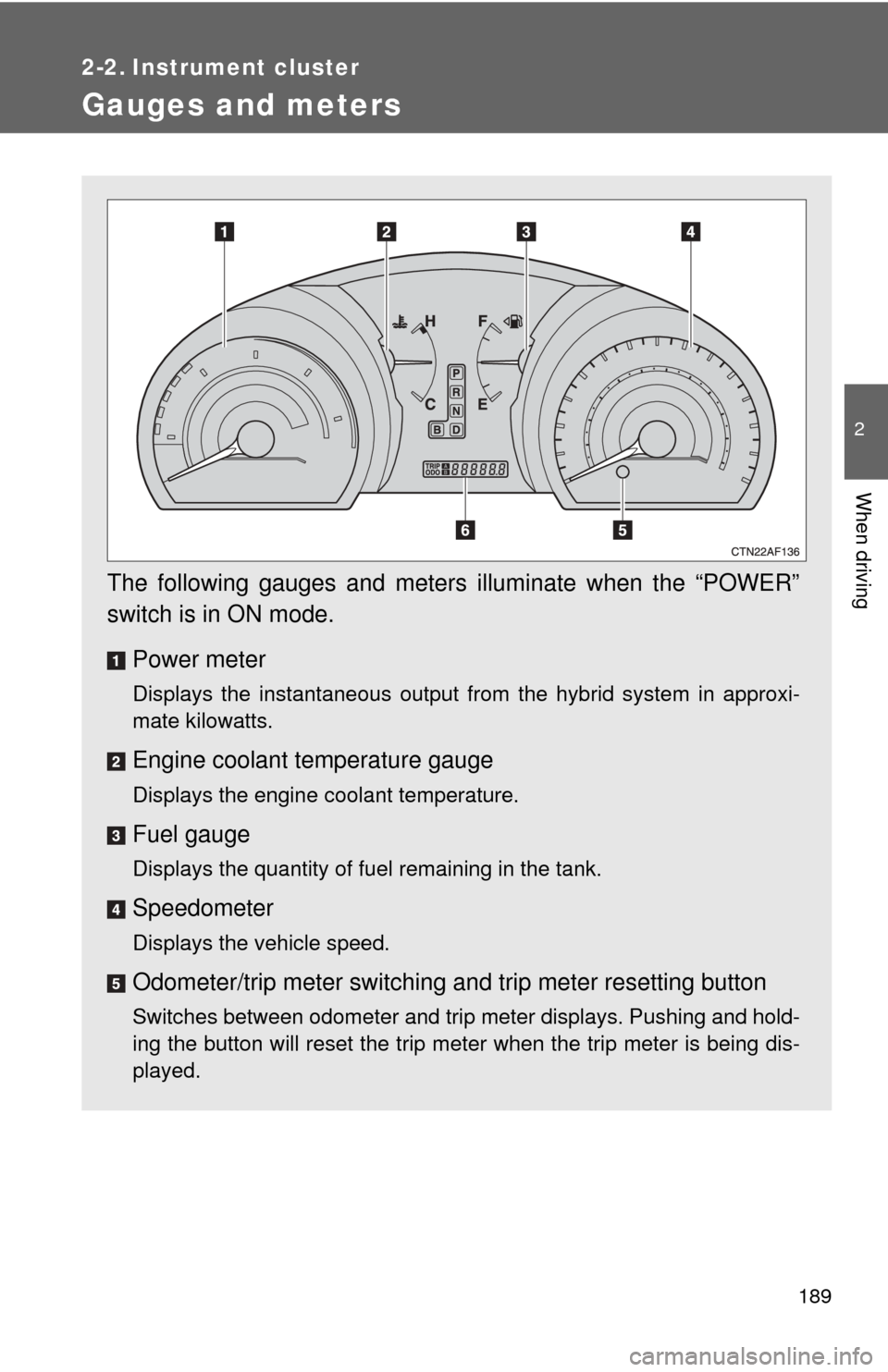
189
2
When driving
2-2. Instrument cluster
Gauges and meters
The following gauges and meters illuminate when the “POWER”
switch is in ON mode.Power meter
Displays the instantaneous output from the hybrid system in approxi-
mate kilowatts.
Engine coolant temperature gauge
Displays the engine coolant temperature.
Fuel gauge
Displays the quantity of fuel remaining in the tank.
Speedometer
Displays the vehicle speed.
Odometer/trip meter switching and trip meter resetting button
Switches between odometer and trip meter displays. Pushing and hold-
ing the button will reset the trip meter when the trip meter is being dis-
played.
Page 236 of 592
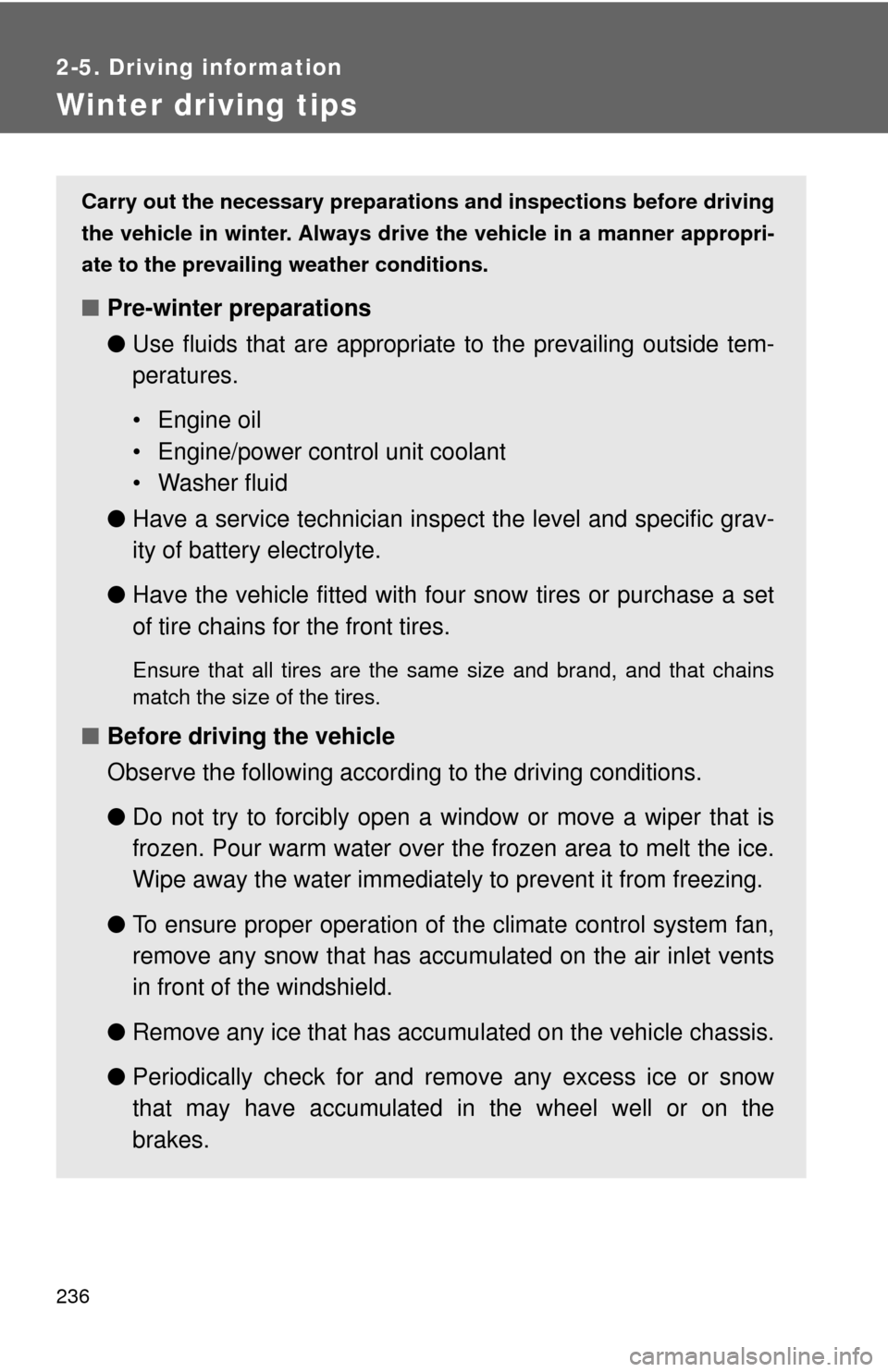
236
2-5. Driving information
Winter driving tips
Carry out the necessary preparations and inspections before driving
the vehicle in winter. Always drive the vehicle in a manner appropri-
ate to the prevailing weather conditions.
■ Pre-winter preparations
●Use fluids that are appropriate to the prevailing outside tem-
peratures.
• Engine oil
• Engine/power control unit coolant
• Washer fluid
● Have a service technician inspect the level and specific grav-
ity of battery electrolyte.
● Have the vehicle fitted with four snow tires or purchase a set
of tire chains for the front tires.
Ensure that all tires are the same size and brand, and that chains
match the size of the tires.
■Before driving the vehicle
Observe the following according to the driving conditions.
●Do not try to forcibly open a window or move a wiper that is
frozen. Pour warm water over the frozen area to melt the ice.
Wipe away the water immediately to prevent it from freezing.
● To ensure proper operation of th e climate control system fan,
remove any snow that has accumulated on the air inlet vents
in front of the windshield.
● Remove any ice that has accumu lated on the vehicle chassis.
● Periodically check for and remove any excess ice or snow
that may have accumulated in the wheel well or on the
brakes.
Page 245 of 592

245
2-5. Driving information
2
When driving
●
Note that when making a turn, th e trailer wheels will be closer than
the vehicle wheels to the inside of the turn. Compensate by making
a larger than normal turning radius.
● Crosswinds and rough roads will adversely affect handling of your
vehicle and trailer, causing sway . Periodically check the rear to
prepare for being passed by large trucks or buses, which may
cause your vehicle and trailer to sway. If swaying occurs, firmly grip
the steering wheel, reduce speed immediately but gradually, and
steer straight ahead. Never increase speed. If you make no
extreme correction with the stee ring or brakes, your vehicle and
trailer will stabilize.
● Take care when passing other vehi cles. Passing requires consider-
able distance. After pass ing a vehicle, do not forget the length of
your trailer, and be sure you hav e plenty of room before changing
lanes.
● Due to the added load of the trailer, your vehicle's hybrid system
may overheat on hot days (at temperatures over 85°F [30°C])
when driving up a long or steep grade. If the engine coolant tem-
perature gauge indicates overheati ng, immediately turn off the air
conditioning (if in use), pull your vehicle off the road and stop in a
safe spot. ( →P. 532)
● Always place wheel blocks under both the vehicle and the trailer
wheels when parking. Apply the parking brake firmly, and put the
transmission in P. Avoid parking on a slope, but if unavoidable, do
so only after performing the following:
Apply the brakes and keep them applied.
Have someone place wheel blocks under both the vehicle and
trailer wheels.
When the wheel blocks are in pl ace, release the brakes slowly
until the blocks absorb the load.
Apply the parking brake firmly.
Shift into P and turn off the hybrid system.
STEP1
STEP2
STEP3
STEP4
STEP5
Page 420 of 592
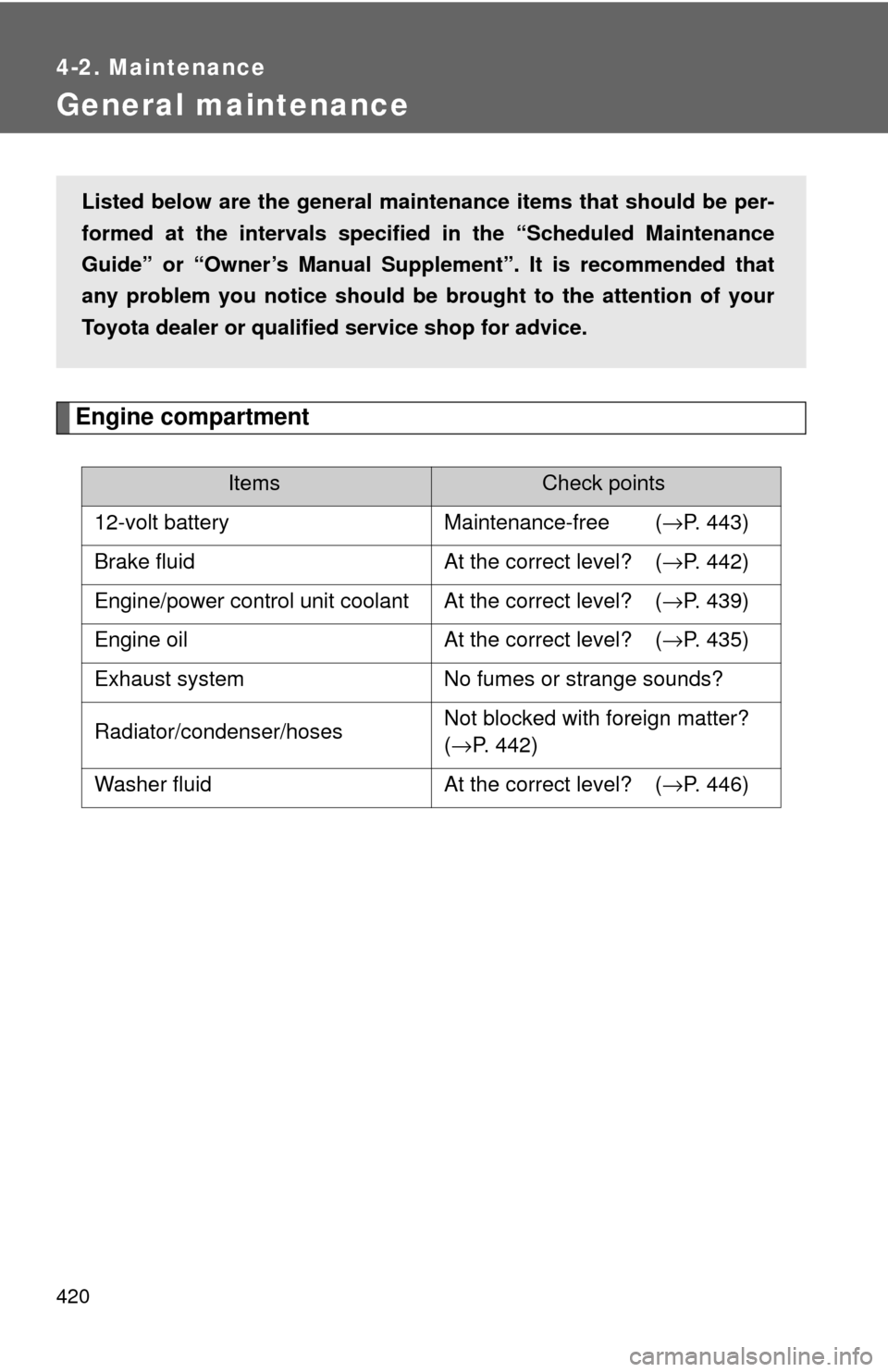
420
4-2. Maintenance
General maintenance
Engine compartment
ItemsCheck points
12-volt battery Maintenance-free (→P. 443)
Brake fluid At the correct level? (→P. 442)
Engine/power control unit coolant At the correct level? ( →P. 439)
Engine oil At the correct level? (→P. 435)
Exhaust system No fumes or strange sounds?
Radiator/condenser/hoses Not blocked with foreign matter?
(
→P. 442)
Washer fluid At the correct level? (→P. 446)
Listed below are the general maintenance items that should be per-
formed at the intervals specified in the “Scheduled Maintenance
Guide” or “Owner’s Manual Supp lement”. It is recommended that
any problem you notice should be brought to the attention of your
Toyota dealer or qualifie d service shop for advice.
Page 424 of 592
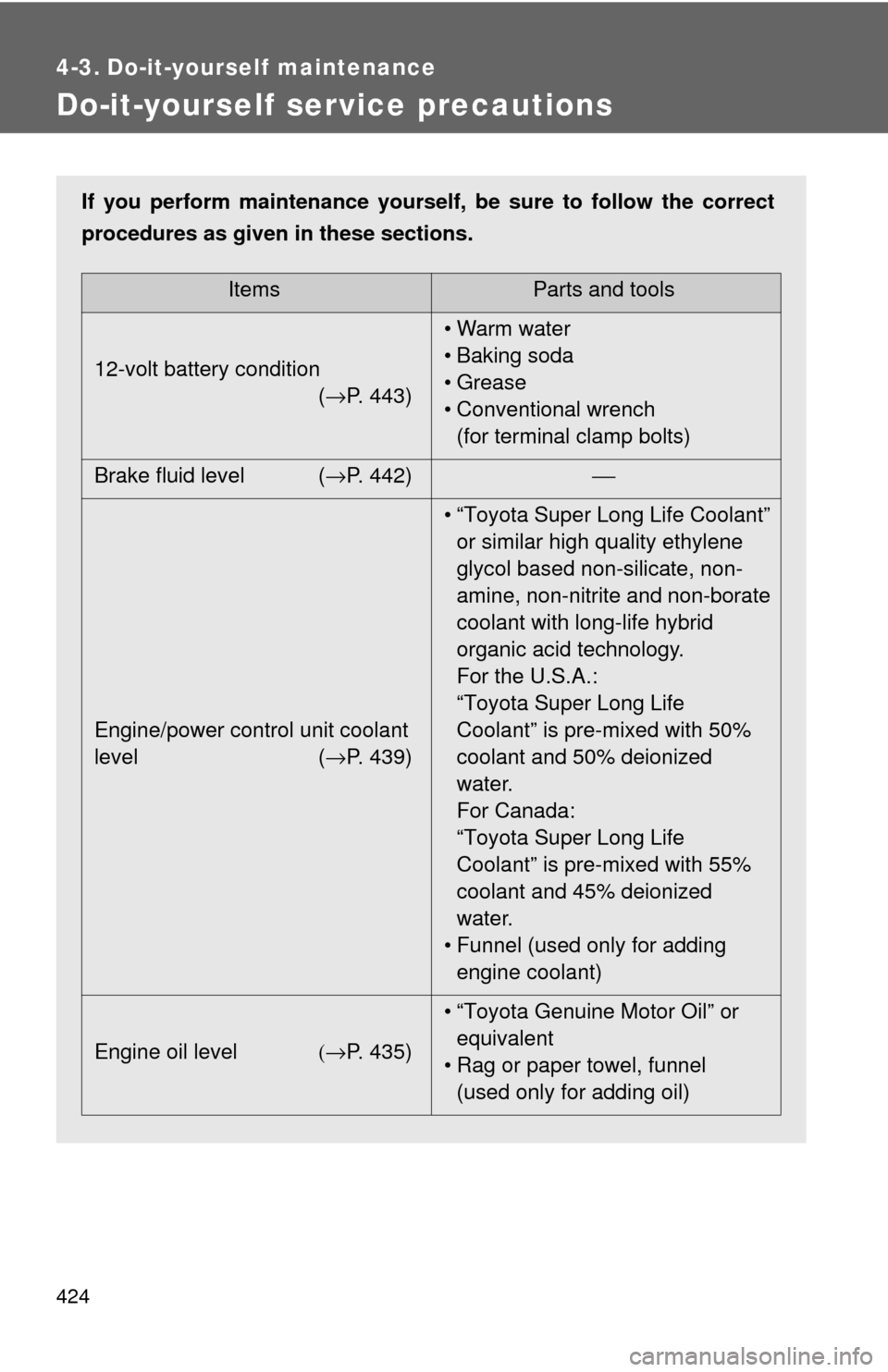
424
4-3. Do-it-yourself maintenance
Do-it-yourself service precautions
If you perform maintenance yourself, be sure to follow the correct
procedures as given in these sections.
ItemsParts and tools
12-volt battery condition (→P. 443) •Warm water
• Baking soda
• Grease
• Conventional wrench
(for terminal clamp bolts)
Brake fluid level ( →P. 442) ⎯
Engine/power control unit coolant
level (→P. 439) • “Toyota Super Long Life Coolant”
or similar high quality ethylene
glycol based non-silicate, non-
amine, non-nitrite and non-borate
coolant with long-life hybrid
organic acid technology.
For the U.S.A.:
“Toyota Super Long Life
Coolant” is pre-mixed with 50%
coolant and 50% deionized
water.
For Canada:
“Toyota Super Long Life
Coolant” is pre-mixed with 55%
coolant and 45% deionized
water.
• Funnel (used only for adding engine coolant)
Engine oil level (→P. 435) • “Toyota Genuine Motor Oil” or
equivalent
• Rag or paper towel, funnel (used only for adding oil)
Page 426 of 592
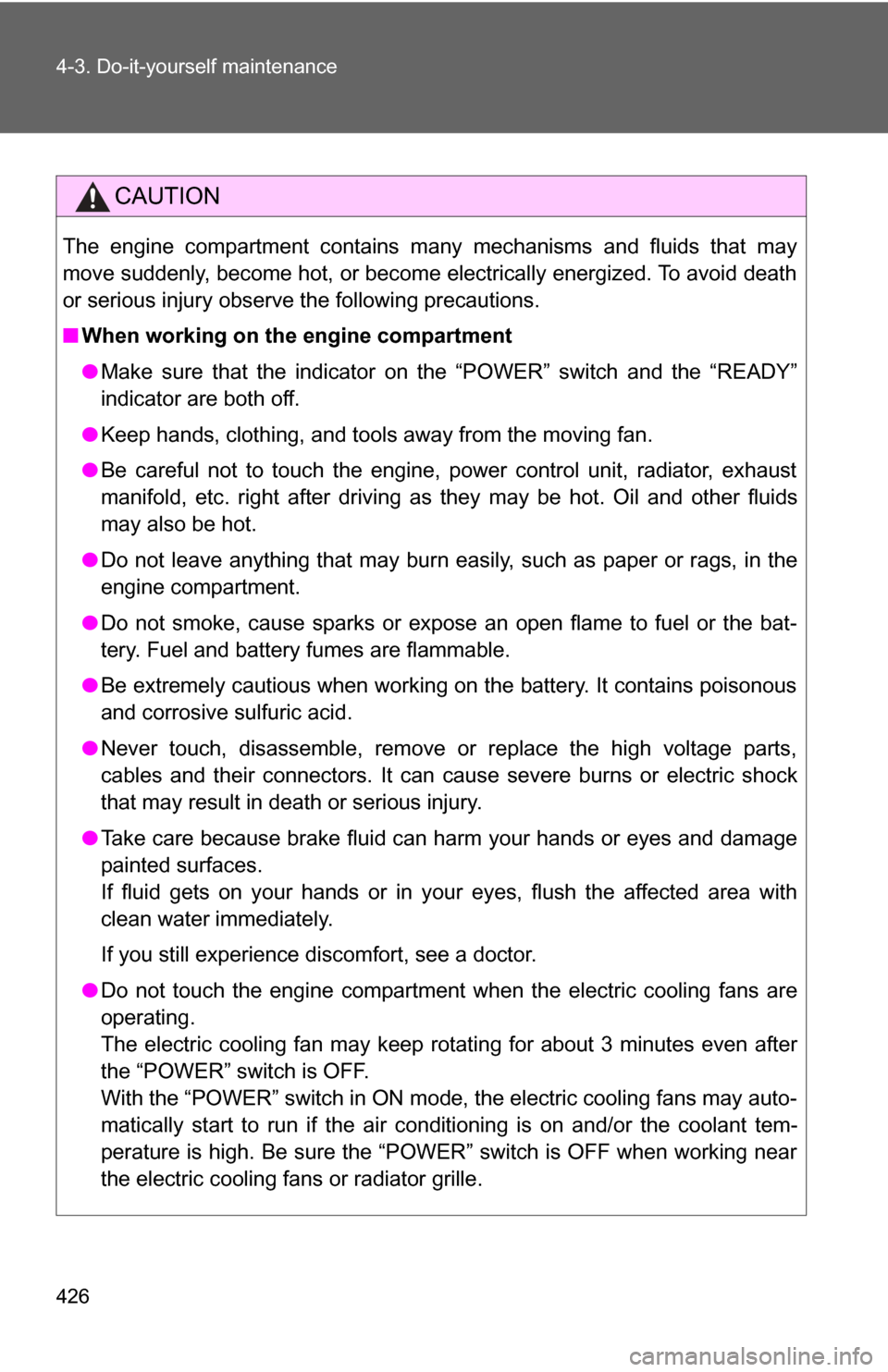
426 4-3. Do-it-yourself maintenance
CAUTION
The engine compartment contains many mechanisms and fluids that may
move suddenly, become hot, or become electrically energized. To avoid death
or serious injury observe the following precautions.
■When working on the engine compartment
●Make sure that the indicator on the “POWER” switch and the “READY”
indicator are both off.
● Keep hands, clothing, and tools away from the moving fan.
● Be careful not to touch the engine, power control unit, radiator, exhaust
manifold, etc. right after driving as they may be hot. Oil and other fluids
may also be hot.
● Do not leave anything that may burn easily, such as paper or rags, in the
engine compartment.
● Do not smoke, cause sparks or expose an open flame to fuel or the bat-
tery. Fuel and battery fumes are flammable.
● Be extremely cautious when working on the battery. It contains poisonous
and corrosive sulfuric acid.
● Never touch, disassemble, remove or replace the high voltage parts,
cables and their connectors. It can cause severe burns or electric shock
that may result in death or serious injury.
● Take care because brake fluid can harm your hands or eyes and damage
painted surfaces.
If fluid gets on your hands or in your eyes, flush the affected area with
clean water immediately.
If you still experience discomfort, see a doctor.
● Do not touch the engine compartment when the electric cooling fans are
operating.
The electric cooling fan may keep rotating for about 3 minutes even after
the “POWER” switch is OFF.
With the “POWER” switch in ON mode, the electric cooling fans may auto-
matically start to run if the air conditioning is on and/or the coolant tem-
perature is high. Be sure the “POWER” switch is OFF when working near
the electric cooling fans or radiator grille.
Page 432 of 592
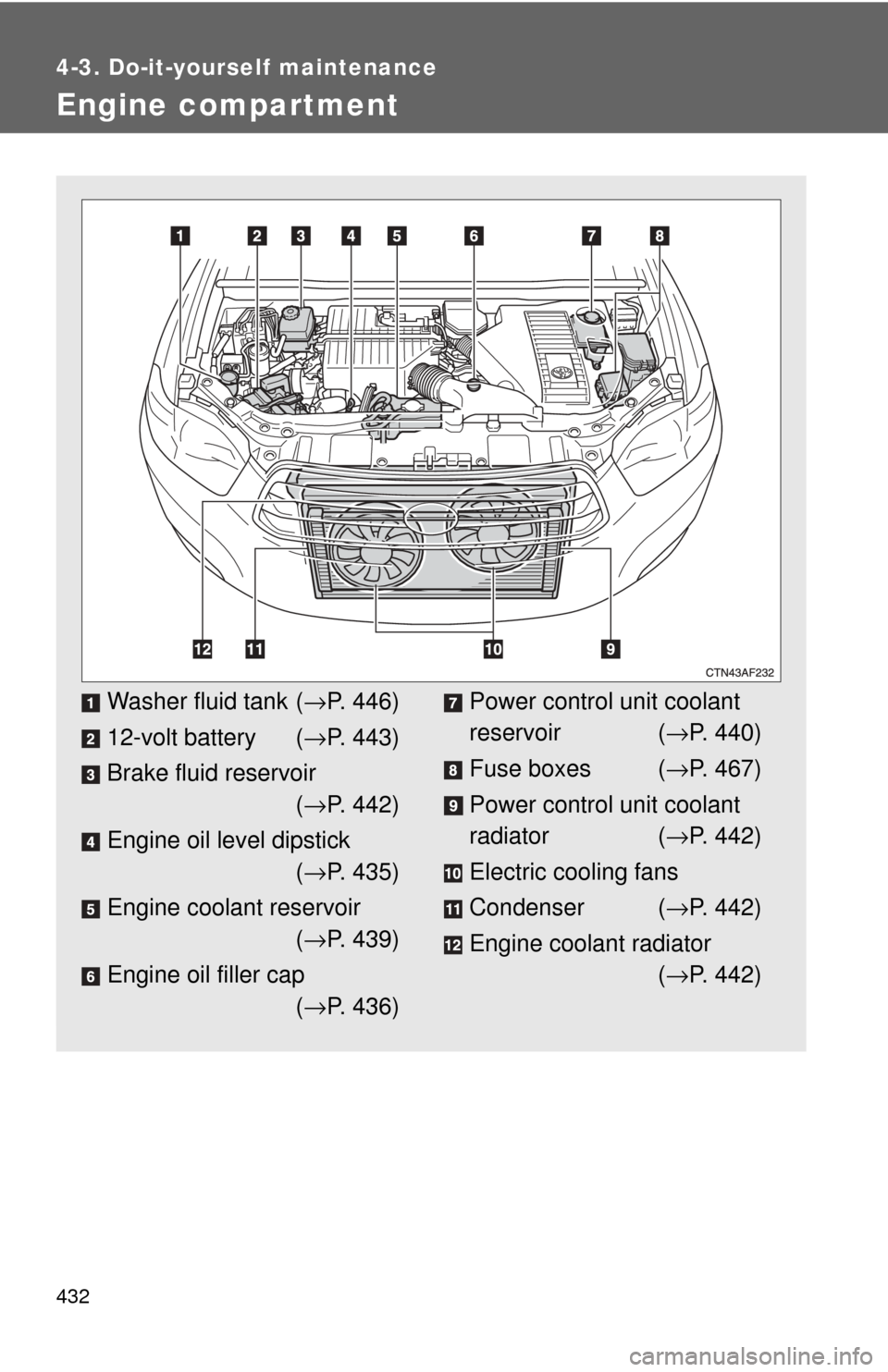
432
4-3. Do-it-yourself maintenance
Engine compartment
Washer fluid tank (→P. 446)
12-volt battery ( →P. 443)
Brake fluid reservoir (→ P. 442)
Engine oil level dipstick (→ P. 435)
Engine coolant reservoir (→ P. 439)
Engine oil filler cap (→ P. 436)Power control unit coolant
reservoir ( →P. 440)
Fuse boxes ( →P. 467)
Power control unit coolant
radiator ( →P. 442)
Electric cooling fans
Condenser ( →P. 442)
Engine coolant radiator (→ P. 442)
Page 439 of 592
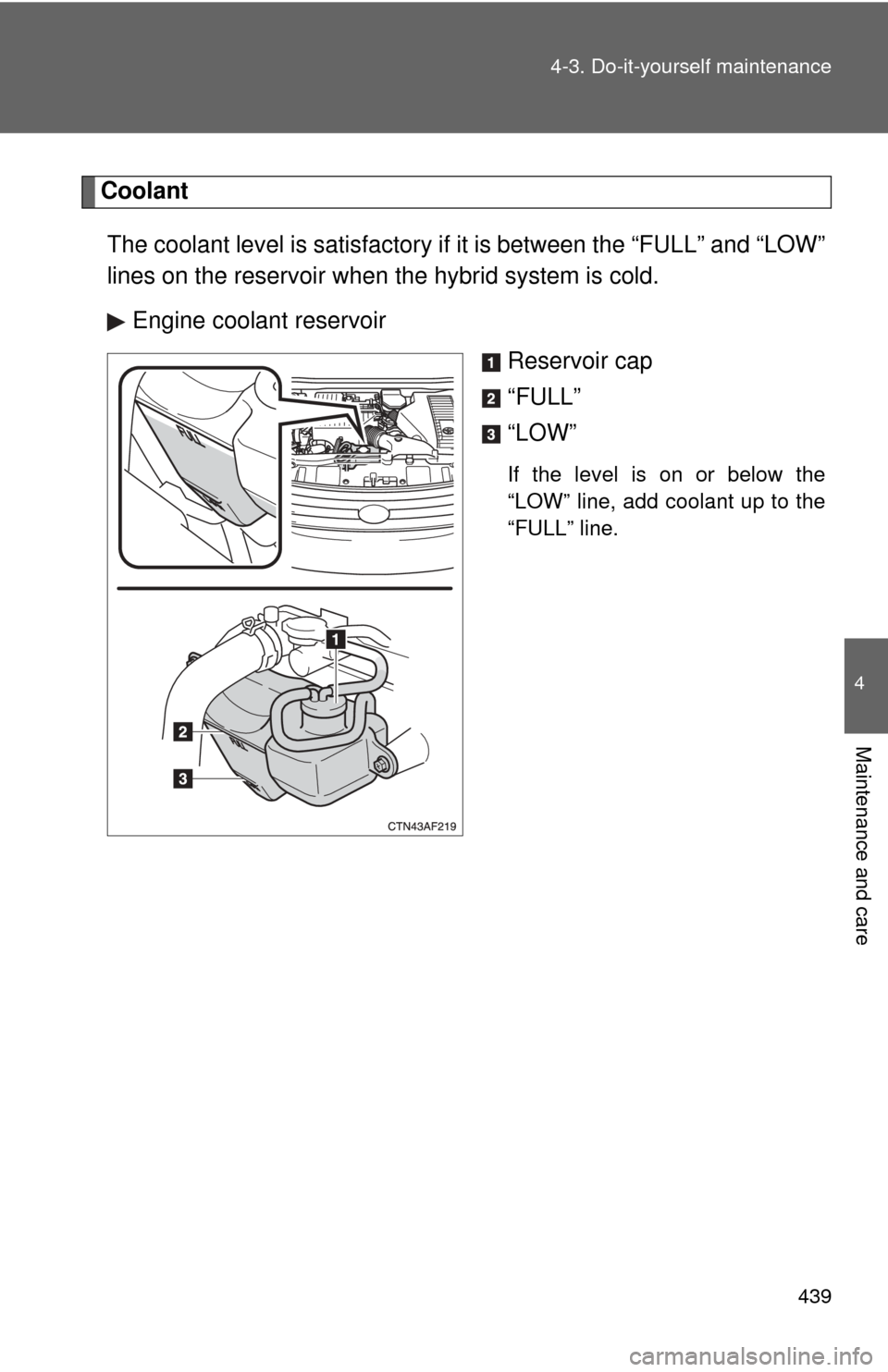
439
4-3. Do-it-yourself maintenance
4
Maintenance and care
Coolant
The coolant level is satisfactory if it is between the “FULL” and “LOW”
lines on the reservoir when the hybrid system is cold.
Engine coolant reservoir Reservoir cap
“FULL”
“LOW”
If the level is on or below the
“LOW” line, add coolant up to the
“FULL” line.
Page 442 of 592
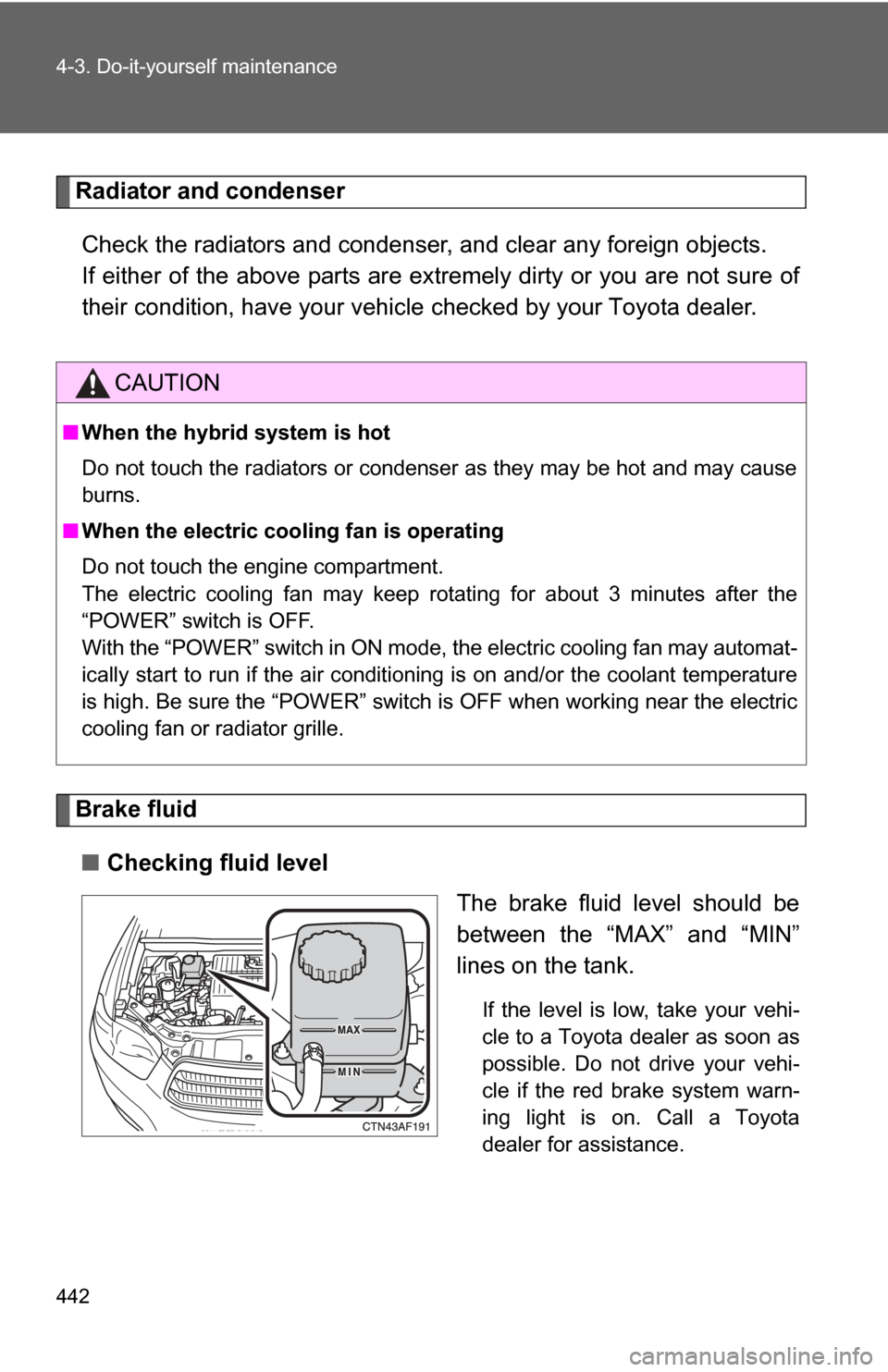
442 4-3. Do-it-yourself maintenance
Radiator and condenserCheck the radiators and condenser, and clear any foreign objects.
If either of the above parts are ex tremely dirty or you are not sure of
their condition, have your vehicle checked by your Toyota dealer.
Brake fluid
■ Checking fluid level
The brake fluid level should be
between the “MAX” and “MIN”
lines on the tank.
If the level is low, take your vehi-
cle to a Toyota dealer as soon as
possible. Do not drive your vehi-
cle if the red brake system warn-
ing light is on. Call a Toyota
dealer for assistance.
CAUTION
■When the hybrid system is hot
Do not touch the radiators or condenser as they may be hot and may cause
burns.
■ When the electric cooling fan is operating
Do not touch the engine compartment.
The electric cooling fan may keep rotating for about 3 minutes after the
“POWER” switch is OFF.
With the “POWER” switch in ON mode, the electric cooling fan may automat-
ically start to run if the air conditioning is on and/or the coolant temperature
is high. Be sure the “POWER” switch is OFF when working near the electric
cooling fan or radiator grille.
Page 497 of 592
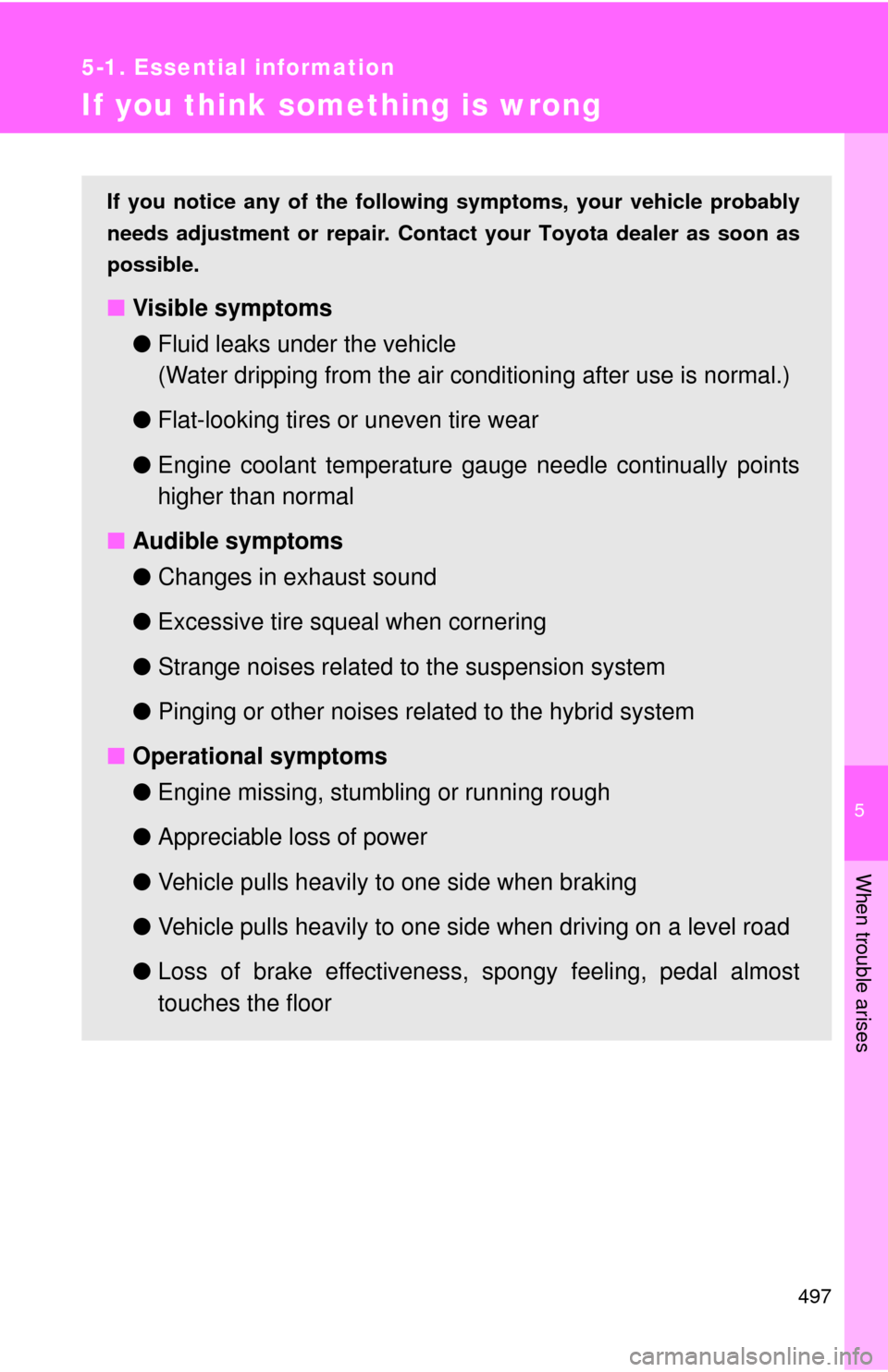
5
When trouble arises
497
5-1. Essential information
If you think something is wrong
If you notice any of the following symptoms, your vehicle probably
needs adjustment or repair. Cont act your Toyota dealer as soon as
possible.
■ Visible symptoms
●Fluid leaks under the vehicle
(Water dripping from the air cond itioning after use is normal.)
● Flat-looking tires or uneven tire wear
● Engine coolant temperature ga uge needle continually points
higher than normal
■ Audible symptoms
●Changes in exhaust sound
● Excessive tire squeal when cornering
● Strange noises related to the suspension system
● Pinging or other noises related to the hybrid system
■ Operational symptoms
●Engine missing, stumbling or running rough
● Appreciable loss of power
● Vehicle pulls heavily to one side when braking
● Vehicle pulls heavily to one side when driving on a level road
● Loss of brake effectiveness, s pongy feeling, pedal almost
touches the floor